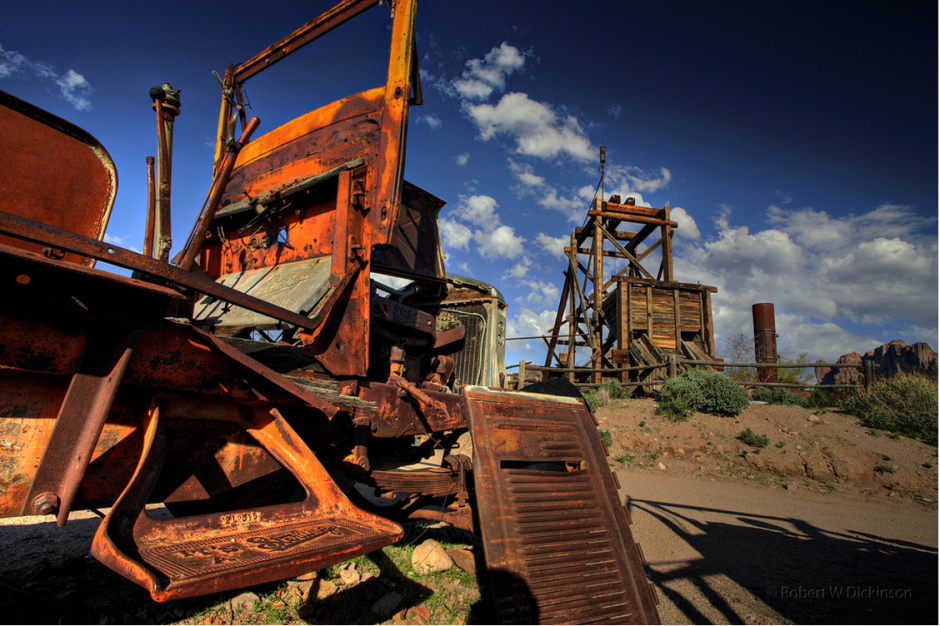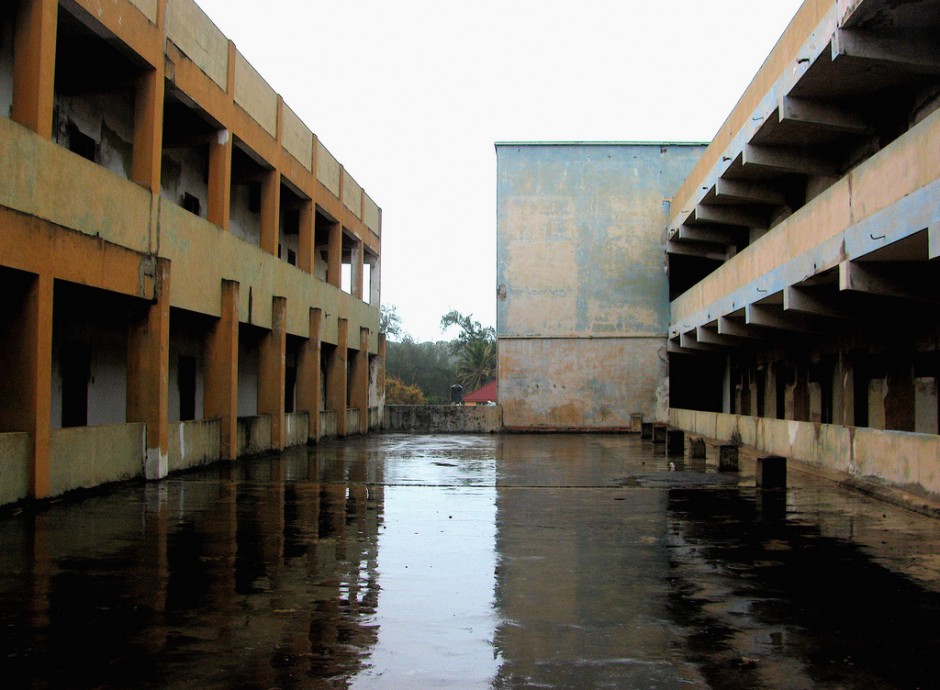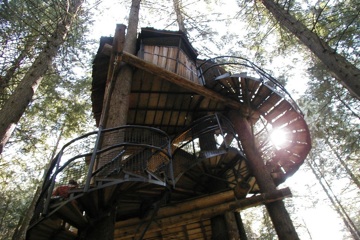SOME TOWNS GROW QUICKLY from the ground up, surging in population. People arrive to work in the mines or factories and build their lives on the frontier. Some towns last, but not these.
The photos below capture the way things look after people leave. Accompanying each image is a description of place — places that for all intents and purposes no longer exist.
1. ‘I think it is best you not know’, Alabama
Many of these old towns had once been thriving county seats, but as commerce left and transportation corridors changed, the glory faded, creating Alabama’s ghost towns.

'I think it is best you not know', Alabama. Photo: Naaman Fletcher
2. Bannack, Montana
Bannack was named after a local Indian nation. After its founding in 1862 it operated as a Montana gold mining town for just over a hundred years before the last residents abandoned it.

Bannack, Montana. Photo: Patty Pickett
3. Ludlow, California
Ludlow was founded as a water stop for the Atlantic and Pacific Railroad in 1883. Several years later miners found ore in the nearby hills. The town boomed from 1906 to 1940 as a railroad town operated by the Pacific Coast Borax Company, which brought borax and other mining products from Death Valley to the rest of the country via long-distance Santa Fe Railway lines.

Ludlow, California. Photo: Fairlane221
4. Dankin, Saskatchewan
Dankin was the site of a former Saskatchewan Wheat Pool grain elevator that was constructed in the early 20th century by United Grain Growers. As the industry left, this structure remained.

Dankin, Saskatchewan. Photo: bonedad
5. Chemung Mine, California
Chemung Mine operated from the earliest days of the 20th century through about 1938. Six or seven buildings survive to this day, and there are still several mines in the vicinity.

Chemung Mine, California. Photo: montpelier
6. Montefalcone, Italy
In 1376 the Lord of Monteverde won control of Fermo with the help of an army of foreign mercenaries. His sheer cruelty earned him the title ‘The Second Nero.’ Three years after his takeover, the citizens rose up against the tyrant, and he fled along with one thousand knights to take refuge in Montefalcone.

Montefalcone, Italy. Photo: dtpancio
7. Bodie, California
In 1876, the Standard Company discovered a lucrative deposit of gold-bearing ore, which changed Bodie from an isolated mining camp to a Wild West boomtown. Discoveries in the adjacent Bodie Mine two years later attracted even more hopeful people.

Bodie, California. Photo: robert.hamilton
8. Gilman, Colorado
Gilman was founded in 1886 as part of the Colorado Silver Boom. The town became the epicenter of lead and zinc mining in Colorado. Nearly 100 years later the town was abandoned by order of the Environmental Protection Agency because of high levels of toxic pollution.

Gilman, Colorado. Photo: numbphoto
9. Goldfield, Arizona
In the 1890s Goldfield was thriving with 3 saloons, a boardinghouse, a general store, a blacksmith, a brewery, a meat market, and a school house. When the quality of ore in the nearby mountains plunged, the town died slowly.

Goldfield, Arizona. Photo: eoscatchlight
10. Kennecott, Alaska
In the summer of 1900, two prospectors in Alaska spotted a green patch of hillside that looked like it’d be good grazing land for their horses. The green turned out to be on top of a mountain of copper ore. They, together with several friends, formed the Chitina Mining and Exploration Company.

Kennecott, Alaska. Photo: Lee Petersen
11. Bodie, California
Bodie began it’s initial decline with the 1912 closure of its newspaper, the Bodie Miner. By the following year the Standard Consolidated Mine had closed. In 1914 mining profits were at an all-time low of $6,821. Three years later, the Bodie Railway abandoned service and scrapped its iron tracks. The last mine closed in 1942. Mining never resumed.

Bodie, California. Photo: After Dark Photo
12. Pripyat, Ukraine
In the early morning hours of April 26, 1986, Reactor No. 4 of the Chernobyl nuclear power plant exploded, releasing a radioactive cloud that spread over much of Europe and western Russia. The disaster affected the lives of millions of people, 350,000 of which were permanently evacuated from their homes in the immediately surrounding area. Pripyat became a ghost town overnight.

Pripyat, Ukraine. Photo: Chris Miller
13. Balaclava, Ontario
Balaclava began as a sawmill in 1855. By the 1860s the town had a blacksmith and a hotel. The water-powered sawmill continued operating until 1959. By that time the depletion of available timber had gravely reduced production.

Balaclava, Ontario. Photo: Perry McKenna
14. Outside of Berlin, Germany
The Olympic Village, 14km west of Mitte, was built between 1934 and 1936. It was used during Hitler’s Olympic games and abandoned once the last Russian soldiers left the area in 1992.

Outside Berlin, Germany. Photo: unkreatives
15. Kolmanskop, Namibia
Kolmanskop declined after World War I when the nearby diamond-field slowly depleted. The town was ultimately abandoned in 1954. The desert consumed the town, with insides of houses knee-deep in sand.

Kolmanskop, Namibia. Photo: coda
16. Chloride, Arizona
In 1898 the Santa Fe Railroad came to Chloride. The community grew to 2,000 people with the discovery of nearby ore. By the 1930s mining had diminished and the railroad had left town.

Chloride, Arizona. Photo: kevincole
17. Silverville, Indiana
All that’s left of Silverville, Indiana, are a few abandoned houses, shops, and this old store.

Silverville, Indiana. Photo: cindy47452
18. Hot Springs, Texas
People traveled long long distances to Hot Springs in search of a cure for a variety of ailments. The site eventually became a full-service facility for invalids looking for treatment in the curative waters.

Hot Springs, Texas. Photo: pbouchard
19. Dachong, China
More then 60,000 people in Dachong were relocated to other parts of Guangdong Province to make way for a massive redevelopment project. 1,400 buildings in this area are scheduled for demolition.

Dachong, China. Photo: dcmaster
20. Shoshoni, Wyoming
Shoshoni had a short-lived love affair with uranium and nuclear power in the 1980s. It didn’t last long, and the population slowly dwindled.

Shoshoni, Wyoming. Photo: gebodogs
21. Salton Sea, California
In 1900 the California Development Company constructed irrigation canals that would divert water from the Colorado River into a dry lake bed called the Salton Sink. These canals made the land fertile for a time, which allowed farmers to plant crops. It didn’t last.

Salton Sea, California. Photo: slworking2
22. Craco, Italy
In the mid-twentieth century, several earthquakes took a toll on the viability of this town. It was then rendered uninhabitable by a series of landslides. These geological threats were due to Craco’s location on a hill of Pliocene sands with overhanging clays and ravines causing progressive incisions.

Craco, Italy. Photo: Tommaso Riva
23. Carabanchel Prison, Spain
The Carabanchel Prison was built by the Franco regime to hold political prisoners after the Spanish Civil War. After its abandonment, the prison was heavily looted and inhabited by squatters. Today many of the walls are covered with elaborate graffiti.

Carabanchel Prison, Spain. Photo: dakotilla
24. Picher, Oklahoma
Picher was once a national center of lead and zinc mining, but after a century of unrestricted excavation the town was left with giant piles of toxic metal-contaminated tailings heaped throughout the area, making the land uninhabitable.

Picher, Oklahoma. Photo: sooner4life
25. Outside of Xai Xai, Mozambique
Xai Xai was hit by flooding of the Limpopo River in 2000, and buildings were left under 10 feet of water. Some commerce returned, but many businesses did not.

Xai Xai, Mozambique. Photo: brendanskinner
26. Drawbridge, CA
In the 1880s, hundreds of weekend visitors flocked to Drawbridge. By the 1920s, the town had nearly 90 buildings, but no roads. Residents slowly left, seeking more convenient living.

Drawbridge, CA. Photo: shawnclover
27. Outside of Alenquer, Portugal
This abandoned factory provides a distant memory of Alenquer’s once thriving industry.

Alenquer, Portugal. Photo: vidadevidro
28. Outside of Le Havre, France
Le Havre was once a German-occupied city devastated by the Battle of Normandy. 5,000 people were killed and nearly 12,000 homes were destroyed by Allied air attacks. Despite this the city became the site of one of the biggest Replacement Depots in the European Theatre of operations in WWII.

Le Havre, France. Photo: fredlh



Great list, ought to include Belchite, Spain as well. http://en.wikipedia.org/wiki/Belchite
Hi! I miss Varosha, Cyprus in this list.It was a popular beach-place in the 70ties and was abandoned after dividing the Island in a greek and a turkish part.
Should be 27 ghost towns – Bodie is on there twice .
.
The only thing scary about these photos is the egregious amount of HDR and over processing. A little bit of photoshop goes a long way.
Interestingly enough this photo wasn’t processed in PS, wasn’t HDR, and was merely several long exposures taken in succession to overcome digital noise and then combined into one image to obtain longer star trails…much like you would with a film shot. Foreground was lit as you see it with a flashlight and the moon. But I can see why skepticism is prevalent with so many heavily processed photographs these days. Blanket statements are never good ones to make….got a link to any of your work Brian?
http://www.flickr.com/photos/7202742@N03/3988964101/
Shawn, sorry if I implied all the photos were over shopped, your photo certainly isn’t. I scrolled through the first several images and that was my impression. There are some good photos here, and yours is no exception, but some have a heavy hand on the saturation and post processing and they feel plastic and little CGI to me.
Doing a proper HDR image is one thing. Totally screwing up an otherwise useable image is inexcusable.
Dear editors. Did you pay these photographers to use their images? Im guessing not. You should pay the photographers. Even a token payment is the right thing to do.
thanks for your concern, stu. owners of all copyrighted photos were contacted and agreed to share their work with us.
But Hal Amen. You’re the managing editor. Do you work for free? Does someone above you ask you to share your time at work for no money? I
I’m guessing not. I don’t blame you personally Hal. You are just part of the ongoing movement to kill pro photography without meaning to.
Pay for crappy “HDR” images? PT Barnum.
HDR Nightmare
Thanks for beating me to it. I wouldn’t have been so polite!
Josh,
Great article! It is so interesting to see some of these forgotten places. I notice a lot of picking at the photos, too bad people can get so busy putting down other artists and miss the overall beauty of the piece.
Cheers
Mexi’s should be in that list !!!!!the basement :s
Some good pix but some look almost like CGI.
I’d highly recommend adding Kayaköy, Turkey to this list. In 1923, the small city of Kayaköy was abandoned because of the population exchange between Greece and Turkey. Amazing to see esp. with the Aegean Sea in the background! http://myturkishjoys.blogspot.com/2011/10/exploring-kayakoy.html
The book ‘Birds Without Wings’ supposedly was inspired by Kayakoy.
Fantastic article. I would love to see some of the American towns.
Shoshoni, WY isn’t a ghost town… it has a population of more than 600 (pretty on par for Wyoming), a mayor and city council, a Greyhound bus stop, a public library, new schools (and separate elementary, Jr. high and high schools), several gas stations and shops… and the buildings in the photo are run down but not abandoned: they contain a funky bar and a soda shop. Perhaps the author should have done a little more research. Other choices, should you want to have Wyoming on the list, would include Bosler, Jeffrey City or Miner’s Delight.
This is one of the things I wanted to point out. Wyoming is full of both ghosts towns, and ones with a population of one family. Highland, WY had a population of 2 when we drove through, and we lived at an abandoned power plant in Acme, WY and were pretty much the only residents.
Very cool pictures. I once stayed at an abandoned silver mine in Honduras, in a place called Parque de los Leones (I think) on the outskirts of Tegucigalpa. It was eerie…I was the only person there. Wish I’d taken pictures!
I think it’s funny that the majority of the list are from the States…Very cool post.
Eerie isn’t it how many of these phantom cities used to be mining towns?
any one happen to know where the Alabama picture was taken? I would love to visit there!
Awesome.
it would of been nice if the author could have included more information on the towns, including how many buildings are still standing and a bit more of the history. Also, being named “…Ghost Towns You Can Visit” does that mean that all of these towns you can walk through, or are some private property and you would be trespassing? Many of the ones in the States are now national parks that you can visit for a fee, but what about the ones in other countries?
They look so freaky. I can’t dare to visit these places alone.